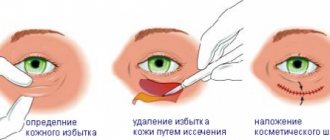Complications are typical for any surgical procedure, but the risks of their occurrence can vary significantly. First of all, the surgeon assesses the woman’s health status and identifies contraindications, which include:
- Inflammatory and infectious processes in the mammary glands.
- Diabetes.
- Pregnancy and breastfeeding period.
- Blood clotting disorder.
- Oncological diseases.
- Severe diseases of the liver, kidneys, lungs, heart, etc.
If breast augmentation is carried out in the presence of contraindications, the risks to the woman’s health and even life will be very high. In this regard, no surgeon will undertake such operations.
Breast augmentation
Augmentation mammoplasty is the most common reason for contacting a plastic surgeon.
And if at the beginning of the century, when the procedure had just gained popularity, paraffin injections were made into women’s breasts, which caused significant harm to health, then modern implants meet all safety standards.
Augmentation plastic surgery
The size and shape of the breast is corrected using different types of implants, which are also called endoprostheses. The shell of the implants is made of plastic silicone, and both silicone and hydrogel or saline (saline solution) can be placed inside it.
Based on their shape, implants are divided into anatomical (drop-shaped) and round.
Anatomical endoprostheses
They look unnatural when lying down and are more difficult to implant, but are the best choice for women with inherently flat chests.
Round implants
Less natural visually and capable of turning over during use, but they are the cheapest and give the breasts maximum volume, lifting them.
The surface of implants can be smooth or textured.
Smooth
Smooth specimens are resistant to damage, soft to the touch and relatively cheap, but can move and often cause contractures.
Textured
Implants are securely fixed after installation and cause less rejection and other problems, but they are tougher, more expensive and last less time.
Access is carried out through the armpits, lower part of the breast or the lower edge of the nipple areola - the specifics of the procedures are determined by the patient’s initial data, the selected implants and the experience of the surgeon.
Endoscopic plastic surgery
A more modern and less traumatic method of breast correction, which takes no more than an hour and a half and does not leave noticeable scars: using an endoscope with miniature cameras, a plastic surgeon inserts implants into the tissue through small punctures.
This method allows you to achieve a better aesthetic effect due to the high accuracy of implant placement, but in terms of complications and rehabilitation period it is not much different from classical endoprosthetics.
Breast lifting
This procedure involves breast correction using the patient's own fat. To do this, it is taken through small incisions using special cannulas, processed for several minutes in a centrifuge to remove blood, dead fat cells and foreign matter, and then distributed to the desired areas through injections. After suturing, the patient is also sent to the hospital.
Long-term postoperative complications
Several months after surgery, some women may experience the following complications:
- Reduced sensitivity up to its complete loss. Usually there is a temporary loss of sensitivity in the nipple area. This complication develops as a result of damage to small nerve fibers that are located in the skin. Sensitivity usually returns after a few months, without any medical help.
- Implant displacement. It develops as a result of violation of the rules of conduct during rehabilitation, in particular, violation of the regime of wearing compression garments, or as a result of the surgeon’s failure to comply with the technical nuances of the operation. This complication is eliminated with repeated mammoplasty.
- Scar formation. Scars always form at the site of the incision, but in most cases they are thin and invisible. In about 1% of women, the scars stretch and increase in size, which affects the appearance of the breasts. They can be eliminated with surgery, but it is carried out no earlier than six months after mammoplasty.
Breast reduction
This type of mammoplasty is used, if necessary, not only for aesthetic reasons, but also to get rid of such consequences of large breasts as pain in the spine and shoulders, spinal deformity, diaper rash and irritation in the submammary area.
Reduction mammoplasty
It allows you to reduce breasts by several sizes, while being one of the most lengthy and traumatic operations for the patient.
The operation is performed exclusively under general anesthesia, during which the surgeon:
- trims away excess skin and fat deposits
- moves the nipple to a higher position while preserving nerve fibers, blood vessels and milk ducts
- if necessary, reduces and corrects areolas and nipples
Scars after such a procedure are very noticeable, because... A vertical or T-shaped incision is used, depending on the size and weight of the tissue being removed.
Breast liposuction
An easier and more gentle method of breast reduction, during which fat from the glands is sucked out using special tubes through small punctures along the contour. It is not recommended for those planning childbearing, as well as for women with a predominance of glandular tissue in the breast.
Complications in the early postoperative period
The most common early complications of breast augmentation surgery include:
- Hematomas and seromas. They develop as a result of accumulation of blood or wound discharge in the implant pocket. These complications are usually accompanied by severe symptoms, so they are not difficult to diagnose. Small hematomas and seromas go away on their own. In some cases, their puncture may be required. If you do not consult a doctor in time, such complications can lead to the breast becoming asymmetrical and painful, requiring removal of the endoprosthesis and its reinstallation.
- Infectious complications. When pathogens enter a wound, both pronounced and subclinical forms of infectious diseases can develop. They are usually manifested by fever, weakness, fatigue, and muscle pain. Treatment is usually conservative and consists of prescribing antibacterial drugs.
Breast correction
The next type of surgical intervention is correction, represented by mastopexy (lift), elimination of asymmetry of the mammary glands and modification of the nipples and areolas, if necessary.
Mastopexy
A breast lift can eliminate the consequences of childbirth or injury, in which the breasts sag, lose shape and elasticity. Despite its apparent simplicity, this is one of the most complex operations, requiring the presence of stitches around the areola or in the lower part of the breast.
During the procedure, excess skin and fatty tissue are excised and the nipples are moved. For a vertical breast lift, the autoaugmentation technique is used, i.e., the upper part of the glands is filled with its own tissues to give a beautiful shape.
Often, mastopexy is combined with the installation of implants if the deformation or original shape of the breast does not allow obtaining the desired result.
Breast asymmetry
One of the most common reasons for visiting a surgeon is different size or shape of the mammary glands. To eliminate this condition, surgery is performed on one or both glands, depending on the patient's wishes.
Areola and nipple correction
Most often, such an intervention is carried out in combination with other procedures, however, asymmetry, uneven contour, size and retraction of the nipples, size and damage to the areolas can become a reason for independent surgery.
Usually people seek correction of inverted nipples, because... This pathology significantly complicates breastfeeding.
One of the reasons for the operation is the so-called. “tubular breast”, in which not only the nipple, but also the areola are completely below the surface of the breast. When the nipple-areolar complex is removed or dies due to other interventions, including the removal of a breast affected by cancer, a new areola is formed.
Any operation on the nipples can damage the milk ducts, and maintaining their patency complicates the procedure and requires special equipment.
Complications that are very rare
The rupture of the implant is accompanied by a violation of the integrity of its shell. Typically, this complication develops as a result of careless actions of the surgeon, as a result of destruction of the implant wall, manufacturing defects, or chest injuries. Modern implants are filled with silicone gel, which does not spread or react with tissues, so there are no serious consequences for a woman’s health in this case.
The rupture can be intracapsular or extracapsular. In the first case, the filler remains within the implant pocket, and in the second, it extends beyond the fibrous capsule. Both of these conditions are usually manifested by aesthetic changes - deformation, asymmetry, change in breast size.
Capsular contracture developed very often (in 40-60% of cases) when using old first and second generation implants. This complication is a normal reaction of the body to a foreign body. He tries to limit the implant to a fibrous capsule from other tissues. The problem is that this capsule is not elastic and compresses the endoprosthesis, resulting in a pronounced compaction in the chest. Modern implants are distinguished by a special type of surface that prevents the formation of capsular contracture. Therefore, currently the risk of developing this complication is less than 10%. It can increase under the influence of other factors, including:
- Subclinical hematoma.
- The pocket is not large enough for the implant.
- Infectious complications after surgery.
However, no connection was found between the likelihood of capsular contracture formation and the type of filler.
The latest models of endoprostheses can reduce the risk of developing this complication to 3%, while in some women it may be higher. Accurate data that would allow us to understand the reasons for the development of capsular contracture have not yet been obtained. Therefore, conscientious manufacturers include a warning insert in each package of implants, which states the possible development of capsular contracture, in which the appearance of the breast may change, which will require repeated surgery.
Preparing for surgery
To enlarge the bust surgically, a woman needs to undergo an examination. Diagnostics include:
- Fluorography.
- Laboratory examination of blood (clinical, biochemical), urine. In addition to standard tests, coagulability, blood type and its Rh factor are determined; glucose level.
- ECG.
- Ultrasound of the mammary glands, determining the degree of their blood supply.
Before the operation, you need to consult an anesthesiologist. Additional types of diagnostics are prescribed on an individual basis. Taking into account the survey responses, it is determined that breast surgery will not have a negative impact on the woman’s body.
At the stage of preparation for surgical breast augmentation, the optimal type of endoprosthesis is selected. The patient’s body type and her expectations from the upcoming intervention are taken into account.










